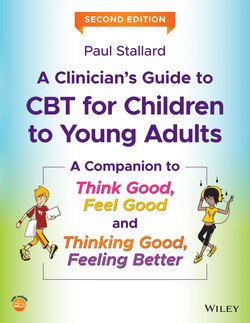Читать книгу A Clinician's Guide to CBT for Children to Young Adults - Paul Stallard - Страница 23
Child‐centred
ОглавлениеThe CORE philosophy clearly places the young person at the very centre of the intervention. Children and young people are a vulnerable group and for this reason it is important to ensure that they are safe, that potential risks are minimised, and that they are appropriately protected from potential harm. There is a need to remain mindful of potential physical, emotional, or sexual harm or exploitation from adults or peers either in person or via the Internet and to take appropriate action to safeguard the young person.
The child‐centred philosophy also ensures that the intervention remains focused on the young person and their problems. Maintaining this focus is important, particularly if parents/carers have their own problems or needs which may dominate clinical sessions and overshadow those of the young person. Parent problems may need to be directly addressed, particularly if they are significantly impacting on the young person’s problems or progress. This needs to be discussed with the parent/carer, whose problems and needs should be acknowledged, and, where appropriate, signposted or referred for direct help in their own right.
Parents/carers or other adults may have their own views about what needs to change, and this may not necessarily be shared by the young person. These views are important, and they need to be heard and acknowledged. However, adult goals may be held and ‘parked’ and returned to at a later stage. The initial focus, wherever possible, should remain on directly engaging the young person and on identifying and working towards their goals. However, the young person’s goals need to be positive and helpful and should not compromise their health or safety in any way. For example, a young person with an eating disorder may choose a goal to maintain (rather than increase) a medically concerning body weight. This would be an inappropriate goal which would compromise the young person’s physical health. This needs to be openly discussed, the reasons why this cannot be supported clarified, and alternative goals identified.
In terms of process, a key objective of the child‐centred approach is the active involvement of the young person in therapy sessions. To maximise engagement, it is important that the young person is provided with plenty of opportunities to contribute during sessions, thereby signalling that their contributions are welcomed, heard, and valued. Clinical sessions therefore need to be conducted in ways that are sensitive to the young person’s level of development and which are consistent with their cognitive, social, and emotional maturity. This will be discussed in more detail when considering the competencies required for partnership working and for pitching the intervention at the right developmental level.
In summary, the child‐centred focus ensures that the young person is safe, that their problems are the primary focus, and that the intervention is carefully attuned to their developmental level to maximise understanding, engagement, and participation.
